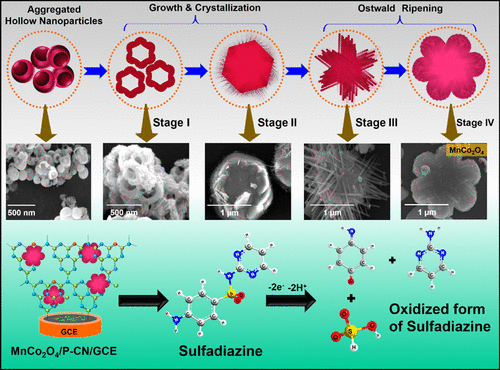当前位置:
X-MOL 学术
›
ACS Appl. Electron. Mater.
›
论文详情
Our official English website, www.x-mol.net, welcomes your
feedback! (Note: you will need to create a separate account there.)
MnCo2O4 Microflowers Anchored on P-Doped g-C3N4 Nanosheets as an Electrocatalyst for Voltammetric Determination of the Antibiotic Drug Sulfadiazine
ACS Applied Electronic Materials ( IF 4.3 ) Pub Date : 2021-09-16 , DOI: 10.1021/acsaelm.1c00506 Balasubramanian Sriram, Jeena N. Baby, Yung-Fu Hsu, Sea-Fue Wang, Xavier Benadict Joseph, Mary George, Pitchaimani Veerakumar, King Chuen Lin
ACS Applied Electronic Materials ( IF 4.3 ) Pub Date : 2021-09-16 , DOI: 10.1021/acsaelm.1c00506 Balasubramanian Sriram, Jeena N. Baby, Yung-Fu Hsu, Sea-Fue Wang, Xavier Benadict Joseph, Mary George, Pitchaimani Veerakumar, King Chuen Lin

|
In this work, hierarchically superior spinel crystalline manganese cobaltite (MnCo2O4) microflowers were hydrothermally synthesized to anchor on phosphorus-doped graphic carbon nitride nanosheet (MnCo2O4/P-CN) nanocomposites for the robust detection of the antibiotic sulfadiazine (SF). The structure and surface characteristics of the obtained composite were measured by the spectroscopic method, which collectively suggests the superior physical and chemical properties of the composite. The anodic oxidation of SF was considered at a glassy carbon electrode modified by MnCo2O4/P-CN (MnCo2O4/P-CN/GCE) using cyclic voltammetry (CV) and amperometry (i–t) techniques. A synergistic relationship between the high-quality flower-like MnCo2O4 and P-CN materials provides high electrical conductivity, larger surface area, and increased surface-active sites. The results indicate that MnCo2O4/P-CN/GCE shows excellent electrocatalytic activity toward the anodic oxidation of SF in pharmaceutical contaminants present in the environment at buffered pH 7.0. The proposed sensor via i–t and differential pulse voltammetry (DPV) results exhibits a wide linear range (LR: 0.008–207.57 and 0.01–95.40 μM), lower detection limit (LOD: 1.2 and 3 nM), and good sensitivity (9.28 and 49.28 μM μA–1 cm–2), respectively, as well as an excellent operational and cycle stability toward the electrochemical determination of SF. The unique structural features of a spinel crystalline MnCo2O4 microflower with symmetrical petals and six trunks can progressively enhance the electrochemical performance of the SF sensor. The state-of-the-art analysis of real samples confirms the possible utilization of Mn–Co-based sensors toward the monitoring of antibiotic residues, thus helping in assessing the behavior of pharmaceutical contaminants in the environment.
中文翻译:

MnCo2O4 微花固定在 P 掺杂的 g-C3N4 纳米片上作为伏安法测定抗生素药物磺胺嘧啶的电催化剂
在这项工作中,水热合成了分级优异的尖晶石结晶锰钴矿(MnCo 2 O 4)微花,以锚定在磷掺杂的图形氮化碳纳米片(MnCo 2 O 4 /P-CN)纳米复合材料上,用于抗生素磺胺嘧啶的稳健检测。 SF)。通过光谱法对所得复合材料的结构和表面特性进行了测量,共同表明该复合材料具有优越的物理和化学性能。SF 的阳极氧化被认为是在由 MnCo 2 O 4 /P-CN (MnCo 2 O 4/P-CN/GCE) 使用循环伏安法 (CV) 和电流法 ( i – t ) 技术。高质量花状 MnCo 2 O 4和 P-CN 材料之间的协同关系提供了高导电性、更大的表面积和增加的表面活性位点。结果表明,MnCo 2 O 4 /P-CN/GCE 在缓冲 pH 7.0 下对环境中存在的药物污染物中的 SF 阳极氧化显示出优异的电催化活性。通过i-t提出的传感器和差分脉冲伏安法 (DPV) 结果显示出较宽的线性范围(LR:0.008–207.57 和 0.01–95.40 μM)、较低的检测限(LOD:1.2 和 3 nM)以及良好的灵敏度(9.28 和 49.28 μM μA –1 cm –2 ),以及对 SF 电化学测定的优异操作和循环稳定性。尖晶石结晶MnCo 2 O 4的独特结构特征具有对称花瓣和六个树干的微花可以逐步增强SF传感器的电化学性能。对真实样品的最新分析证实了锰钴基传感器可能用于监测抗生素残留,从而有助于评估环境中药物污染物的行为。
更新日期:2021-09-28
中文翻译:

MnCo2O4 微花固定在 P 掺杂的 g-C3N4 纳米片上作为伏安法测定抗生素药物磺胺嘧啶的电催化剂
在这项工作中,水热合成了分级优异的尖晶石结晶锰钴矿(MnCo 2 O 4)微花,以锚定在磷掺杂的图形氮化碳纳米片(MnCo 2 O 4 /P-CN)纳米复合材料上,用于抗生素磺胺嘧啶的稳健检测。 SF)。通过光谱法对所得复合材料的结构和表面特性进行了测量,共同表明该复合材料具有优越的物理和化学性能。SF 的阳极氧化被认为是在由 MnCo 2 O 4 /P-CN (MnCo 2 O 4/P-CN/GCE) 使用循环伏安法 (CV) 和电流法 ( i – t ) 技术。高质量花状 MnCo 2 O 4和 P-CN 材料之间的协同关系提供了高导电性、更大的表面积和增加的表面活性位点。结果表明,MnCo 2 O 4 /P-CN/GCE 在缓冲 pH 7.0 下对环境中存在的药物污染物中的 SF 阳极氧化显示出优异的电催化活性。通过i-t提出的传感器和差分脉冲伏安法 (DPV) 结果显示出较宽的线性范围(LR:0.008–207.57 和 0.01–95.40 μM)、较低的检测限(LOD:1.2 和 3 nM)以及良好的灵敏度(9.28 和 49.28 μM μA –1 cm –2 ),以及对 SF 电化学测定的优异操作和循环稳定性。尖晶石结晶MnCo 2 O 4的独特结构特征具有对称花瓣和六个树干的微花可以逐步增强SF传感器的电化学性能。对真实样品的最新分析证实了锰钴基传感器可能用于监测抗生素残留,从而有助于评估环境中药物污染物的行为。











































 京公网安备 11010802027423号
京公网安备 11010802027423号